Burdekin grazing update
May 2023
In this edition:
A drink, a feed and a decent rest | Clermont cattlemen’s challenge update | Northern Grassfed Carcass Competition is on again | Botulism case study provides timely reminder
A drink, a feed and a decent rest
Bec Clapperton – Department of Agriculture and Fisheries, Townsville
When someone I know well is starting to get a bit agitated or isn’t performing on all cylinders, the first thing I usually think is when was the last time you had a decent feed, had a good night’s sleep, or had a holiday?! And if you think about it, we could ask the same questions of our pastures. They too need a feed (nutrients and sunlight), a drink (moisture), and even a decent rest to keep up their performance, just like us!
DAF have recently been helping a property in the lower Burdekin to implement some rest into a few paddocks. The results so far have been great.
This is an old cultivation paddock next to a set of cattle yards. Soil tests revealed adequate nutrient levels, however it was suffering from some soil compaction, and hadn’t been rested for some time. The first port of call was to deep rip it to aid with soil compaction, apply some rest, and see what happened. Historically a lot of water sat on the surface of this paddock after any rainfall event. After deep ripping it in January, the producers have noted that any rainfall this year has soaked straight in, with no water left sitting on the surface.
The paddock has also been rested since December. Check out the results so far after a good drink and some rest!
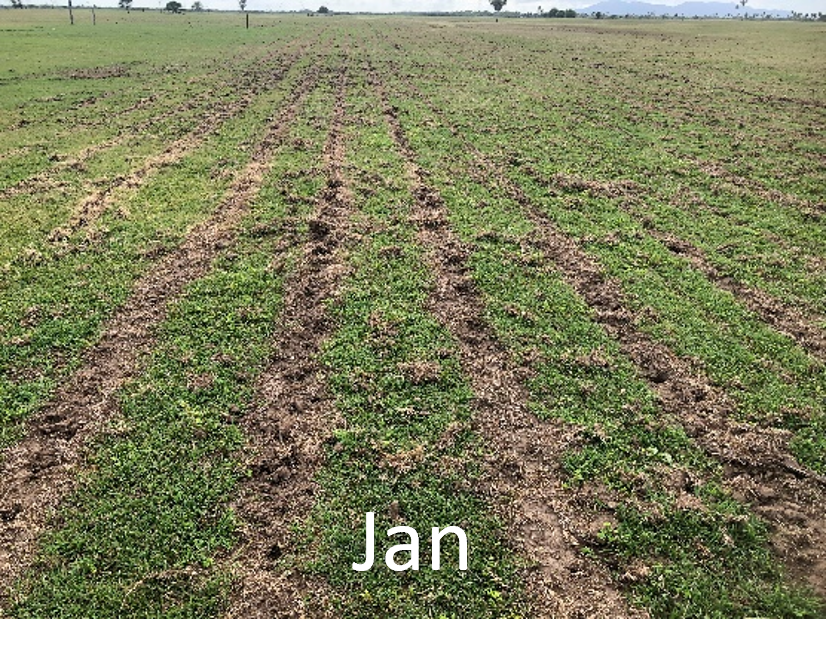 | 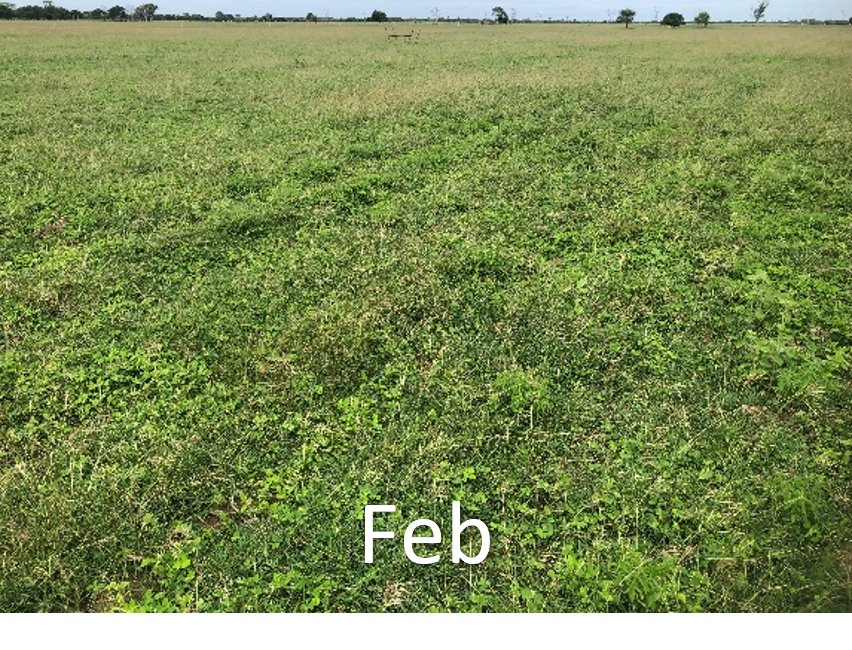 |
This second paddock had a higher proportion of broad leaf weeds encroaching on the pasture. After being deep ripped and just two months rest, a wide variety of desired grass and legume species have come back.
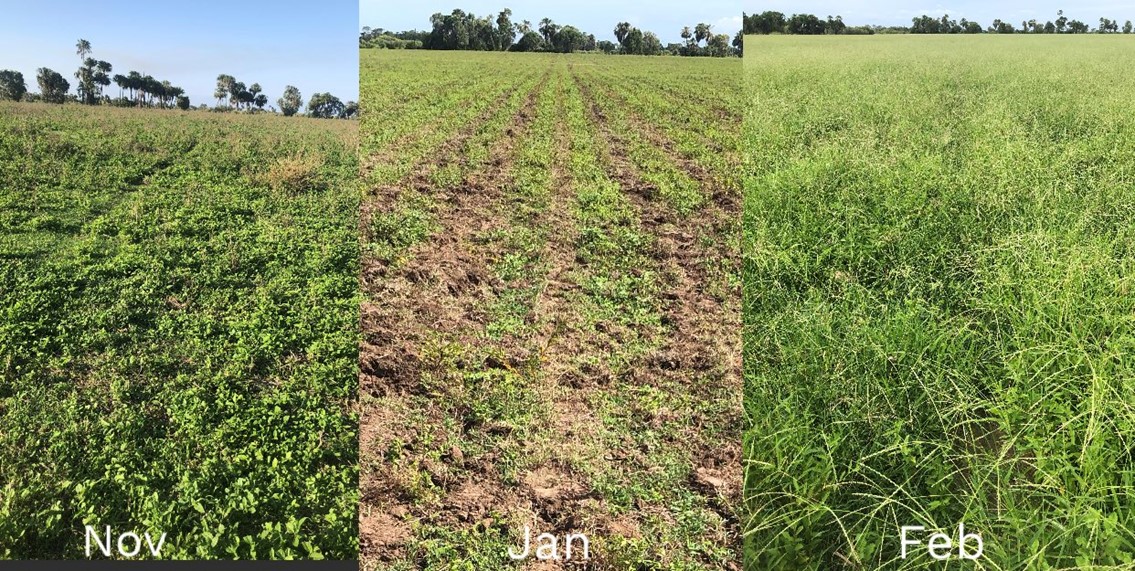
If your paddocks are looking a bit tired, or not performing as well as you would like, now is a great time to start planning what paddocks you will give a rest during the coming wet season.
Clermont Cattlemen’s Challenge update
Roxanne Morgan — Department of Agriculture and Fisheries, Mackay
The 2022/23 Clermont Cattlemen’s Challenge is drawing to a close as exhibitors attend Paringa Feedlot for the Annual Feedlot Field Day and Steer Finals Nominations.
The Clermont Cattlemen’s Challenge has been part of the Clermont Show for many years. It is a marathon competition, with steers monitored over 12 months for their market suitability. Graziers nominate a pen of 5 weaner steers (optimal liveweight 280-320kg) to be judged as a Pen of 5 Steers Suitable to Grow for the 100 Day Grain Fed Market. These are agisted together on a local property for 8 months, then finished on grain for 100 days in a local feedlot in preparation for one to be judged as a carcase and three returning to the following Clermont Show to be judged as a Pen of 3 Steers Suitable for the 100 Day Grain Fed Market. A cube roll from each carcase steer is judged at the Show in the Annual Taste Test Competition. Points are awarded for 1-5 placings in each category, as well as for entering the competition at less than 320kg and the Pen of 3 Steers with the Highest Overall Weight Gain.
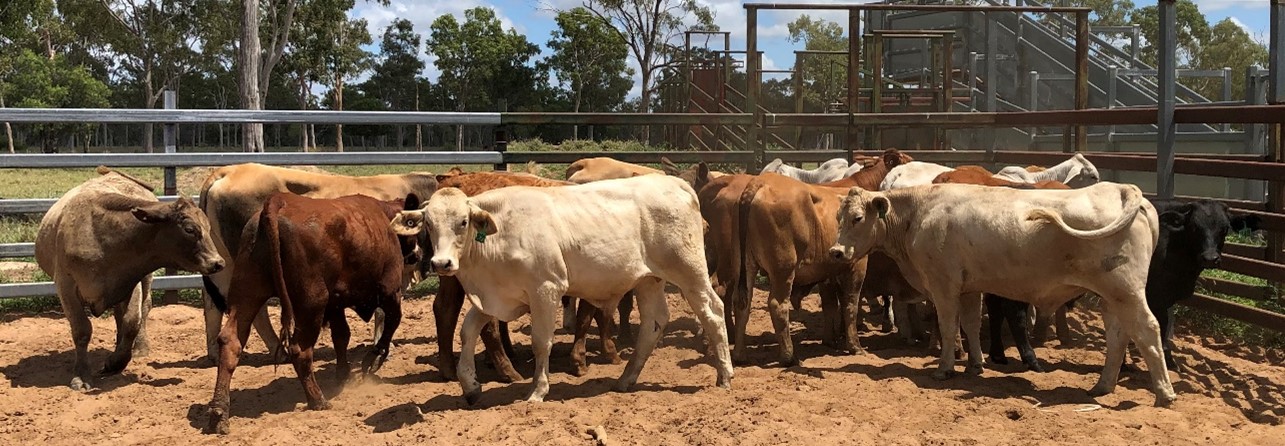
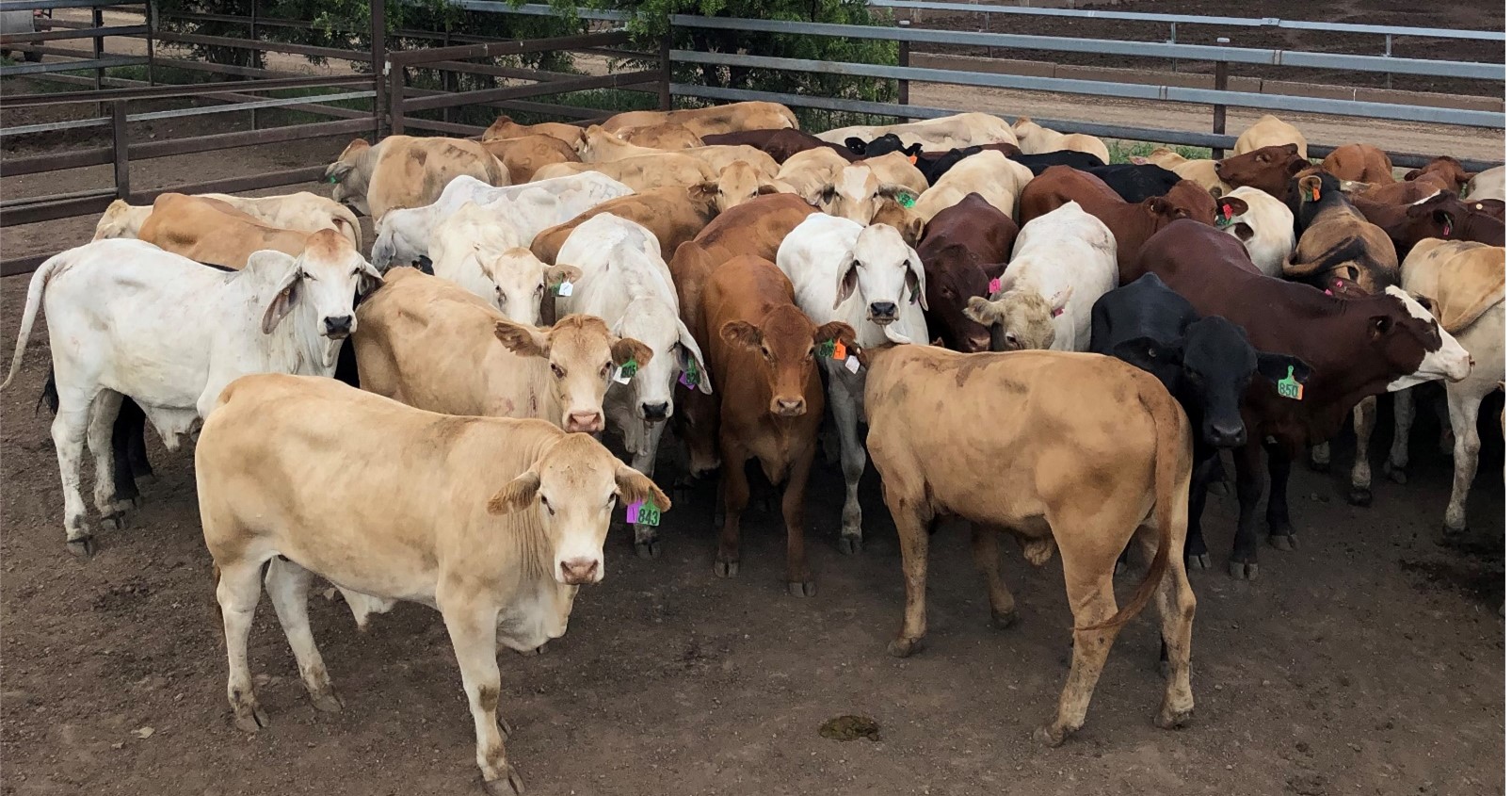
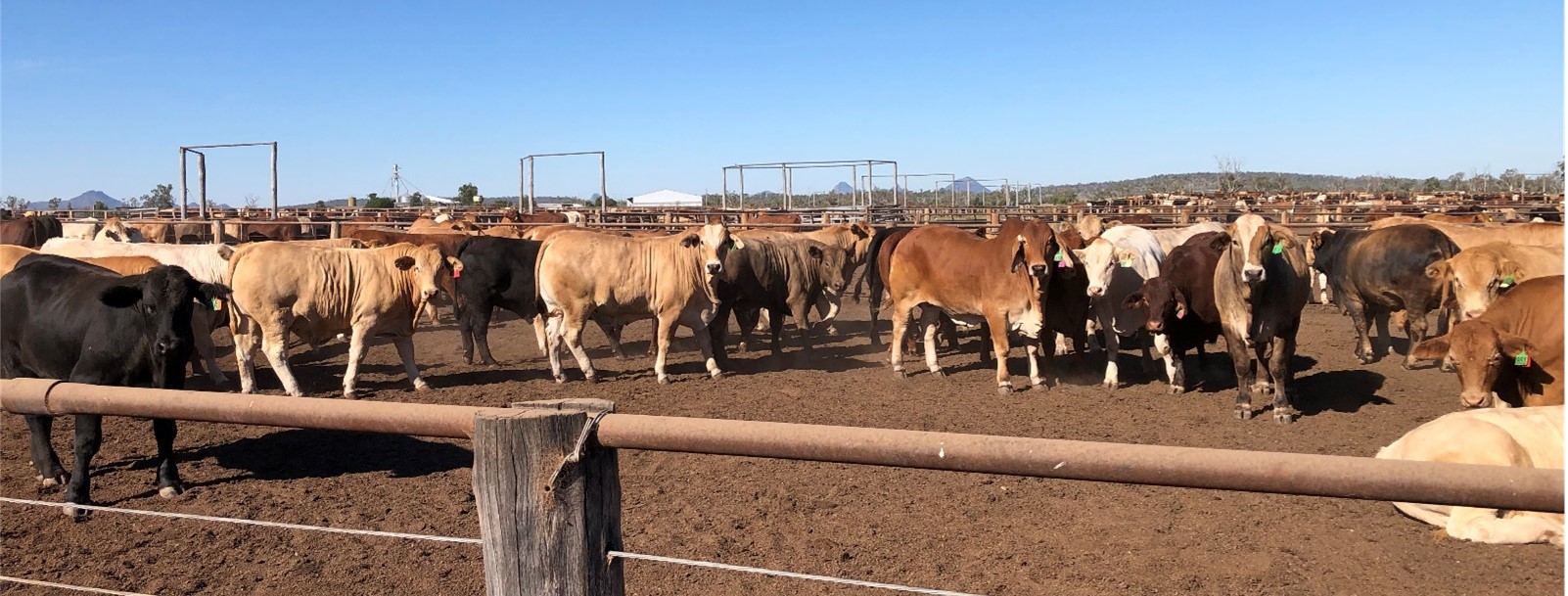
The 2022/23 competition sees 11 vendors vie for the title of 2023 Cattle King and Queen. On Friday 19th May, approximately 30 people attended Paringa Feedlot to see how the steers had performed and hear presentations from the Northern Genomics Project and Black Box Co. Staff from the Department of Agriculture and Fisheries collated performance data for the current steers and presented an overview of this year’s steer performance.
Elsie Dodd, UQ/QAAFI Beef Liaison Officer for the Northern Genomics Project, explained to everyone how GBVs (Genomic Breeding Values) can be utilised to compare genetic performance between breeds, including crossbreds and within herds. Tropical beef GBVs have been developed for traits of high economic importance including:
- growth (weight and hip height at approx. 18 months of age)
- female fertility (age of heifer puberty; P4M – pregnant within 4 months of calving)
- adaptation (body condition score at approx. 18 months of age; temperament; buffalo fly lesions; tick score).
GBVs can be calculated for individual animals, or a minimum of 25 animals from a cohort (for example weaner heifers). Animals are compared against a reference population of 30 000 females from 50 commercial beef herds throughout northern Australia who were monitored from approximately 18 months of age to weaning their first calf (the first phase of the Northern Genomics Project) for the above traits. This provides a ranking for the herd’s performance. Examples were given of how producers can utilise this information to purchase bulls who complement the current herd’s attributes. For more information, please contact Elsie Dodd on 0427 993 779 or e.dodd@uq.edu.au.
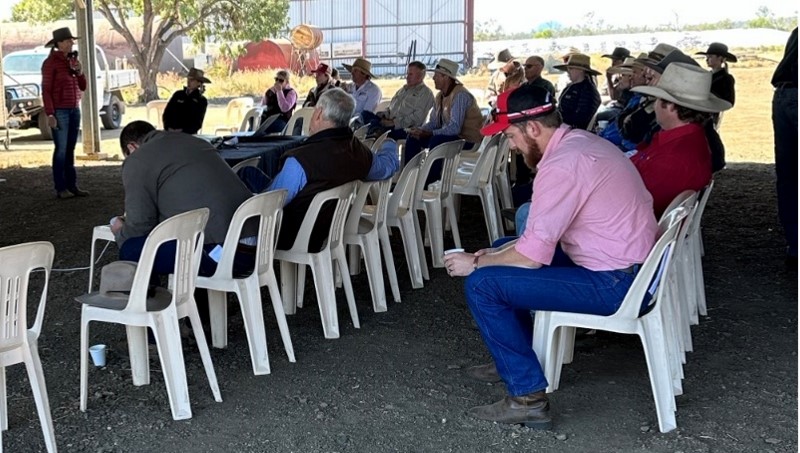
Georgia Dale, Business Development Manager for Black Box Co, provided insights into the data analysis tool which links on farm performance data through to feedlot feedback and abattoir grading information. The system builds on the data collected in existing hardware systems (eg Gallagher, Tru-test, Stockbook and more) and data available past the point of sale – feedlot and carcase feedback. Their working relationships with many feedlots and abattoirs allow (with producer consent) importation of various data sets to enable analysis of performance throughout the life of an animal, across the supply chain based on RFID. This has many benefits, including highlighting reasons for animals falling outside of specifications at feedlot entry and processing, identifying highest or lowest producing animals, and projecting the number (and individual RFID numbers) of animals expected to reach specific targets at future dates within minutes. Georgia/Black Box Co can be contacted on 0498 135 738 or email georgia@blackboxco.com.au.
Roxanne Morgan, Beef Extension Officer with the Department of Agriculture and Fisheries, provided an overview of this year’s Challenge, including the treatments administered to the steers, and paddock and climate characteristics at Mt Douglas where they were agisted from May 2022 to February 2023. Discussion was generated around a faecal egg count test which was performed in October. 15 steers were sampled and egg counts ranged from 0-1120epg (eggs per gram). Based on these results, steers were weighed and treated with Dectomax V in November. There was no significant difference in weight gains between the high and low egg count steers before or after the treatment, suggesting this wasn’t a primary cause of variation in average daily gain.
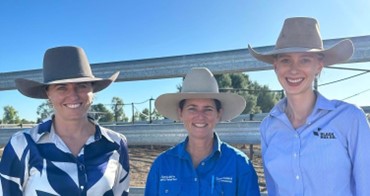
Emily Crowe, DAF Economist, with the assistance of the Bullocks tool from the Breedcow & Dynama online package, established the gross margin and return on investment for multiple scenarios of selling the steers at each weigh point – November 2022, February 2023, or after the 100 days on grain. Most people would be aware prices have come right back from record highs for young cattle in May 2022, with liveweight prices then almost matching current dressed weight prices. Selling the steers in May last year and funding some capital works, or resting country with low ground cover to improve land condition would have likely provided a better return on investment.
Overall steer performance was just below 1kg/day. The 55 steers averaged 0.50kg/day (128kg) during the grass phase of the competition and 2.09kg/day (219kg) on grain. They averaged 301kg on 22/05/2022 and 649kg at Paringa on 18/05/2023.

A BBQ lunch kindly sponsored by Top Paddock Consulting and JBS, and organised by Sonya Harvey and the Blair House Student Hostel team, allowed time to discuss how GBVs and Black Box analysis could be incorporated into the Clermont Cattlemen’s Challenge. A big thank you goes to Paringa for hosting the day and allowing us to follow the steers through their feedlot phase.
Everyone is invited to Clermont Show 29 – 31st May to see the winning pens of steers and participate in the Consumers Choice Taste Test Competition at 2pm Tuesday under the fig trees near the Agent’s Kiosk at Clermont Showgrounds. Tickets for the show can be purchased online at http://clermontshow.com.au/tickets/. The Cattle King and Queen will be announced at the 2023 FMC Trophy Presentations & Graziers Lunch on Wednesday 31st May.
Northern Grassfed Carcass Competition is on again in 2023
Bec Clapperton – Department of Agriculture and Fisheries, Townsville
After the success of the inaugural Northern Grassfed Carcass Competition in July 2022 at JBS in Townsville, organisers are gearing up for an even better event this year. The competition gives cattle producers an opportunity to receive detailed carcass feedback through the MSA grading process, as well as to see how their beef stacks up, underneath the hide.
The winning pen last year were Charbray heifers off improved pastures at Gumlu. The competition will run again in July 2023, with cattle to be delivered on Monday 10 July to JBS in Townsville. If you are interested in entering a pen of cattle this year, please contact JBS to secure your spot as places are limited.
Competition specifications:
- pen of three grassfed steers or
- pen of three grassfed heifers
- dressed carcass weight between 280-340kg
Points are awarded for:
- MSA index
- lean meat yield
- fat coverage
Cattle with high weight for age, smaller hump height, and no HGP, do well through the MSA grading. All cattle are encouraged to be entered, as this is a fantastic opportunity to receive detailed carcass feedback, which can then be used to help you improve your herd.
More information on preparing cattle for MSA grading.

To register your interest, or for more information, please contact:
Simon Fraser- JBS Townsville 0400314281 simon.fraser@jbssa.com.au
Bec Clapperton- DAF Townsville 0477 345 843 bec.clapperton@daf.qld.gov.au
Botulism case provides timely reminder
Lara Landsberg – Department of Agriculture and Fisheries, Mackay
A recent outbreak of botulism in a cattle herd near Sarina was reported to Mackay biosecurity officer, Emily Baretta, over the Christmas period. The outbreak resulted in multiple cattle deaths and likely developed from cattle chewing on a turtle carcase.
“Once botulism was identified as the cause, the producer did all the right things in handling the situation by immediately inoculating the remaining unaffected animals,” said Emily. “They also burnt the carcases of the affected animals to prevent further spread of the toxin.”

The herd was not being supplemented with phosphorous (P) at the time of the outbreak, however supplementation has since been provided to the herd. The livestock readily consumed the provided P supplement, indicating a likely P deficiency. Soil testing will be undertaken to determine the soil P status.
If anyone has any concerns, call 13 25 23 to speak to a Queensland biosecurity officer from anywhere across the state who will help you resolve the issue.
The case provides a timely reminder that cattle can appear to be doing well and still be phosphorus deficient – they just won’t be reaching their production potential. Bone and carrion chewing is the principal source of botulism toxin and can be a symptom of a phosphorous deficiency or a severe protein deficiency. With a good season, when the grass is green and abundant, phosphorous generally becomes the limiting nutrient in the pasture and a nutritional supplement may be required to fix deficiencies (information about phosphorus supplementation is available here).
Botulism – what is it?
Botulism is a disease caused by exposure to botulinum toxins which are produced by the Clostridium botulinum bacterium under low-oxygen conditions.
Botulinum toxins are one of the most lethal substances known and travels via the bloodstream to block nerve functions which leads to respiratory and muscular paralysis.
What does it look like?
Symptoms vary depending on the toxin dose from slow progressive paralysis to sudden death (animals collapse and die in a couple of hours). Ultimately, cattle die of respiratory failure due to paralysis of the breathing muscles.
Signs of a prolonged condition include:
- wobbly or stiff gait (staggers)
- paralysis begins in the hind legs and progresses towards the head
- animals off feed and water – unable to eat or drink (facial paralysis)
- tongue hanging out of mouth and unable to be withdrawn
- drooling
- drooping eyelids
- shallow breathing
- down cattle with hind legs extended behind them – an attempt to make breathing easier.
Not all affected animals will die but once down, the likelihood of recovery is poor.

Ephemeral fever (3-day sickness) can present similar symptoms, but cattle will have a fever –botulism will not cause a fever.
What to do
If you suspect your herd may be affected:
- Immediately remove remaining cattle from suspected contamination source.
- Vaccinate unaffected cattle.
- Burn and bury affected carcases to prevent any further spread.
How to prevent
Vaccinate your cattle with either single dose vaccine Longrange® or SingVac®, or two dose vaccine Ultravac®Botulinum. Vaccines are available from vets, produce agents, and rural retailers. More information on handling, administering, and storing vaccines here.
Note: it can be too late to vaccinate a herd if an outbreak has already occurred (the vaccines take 28-35 days to provide protection).
Other management practices to help reduce risk:
- Provide nutritional supplementation to reduce bone chewing behaviour
- Dispose of animal carcasses by burying, burn and burying, or fencing off to prevent stock access
- Control pest animals to reduce spread of carcase material
- Check water sources for organic matter contamination
The most effective strategy is to vaccinate cattle. If you are in a risk area, vaccinate your stock to make this one less problem to worry about!
